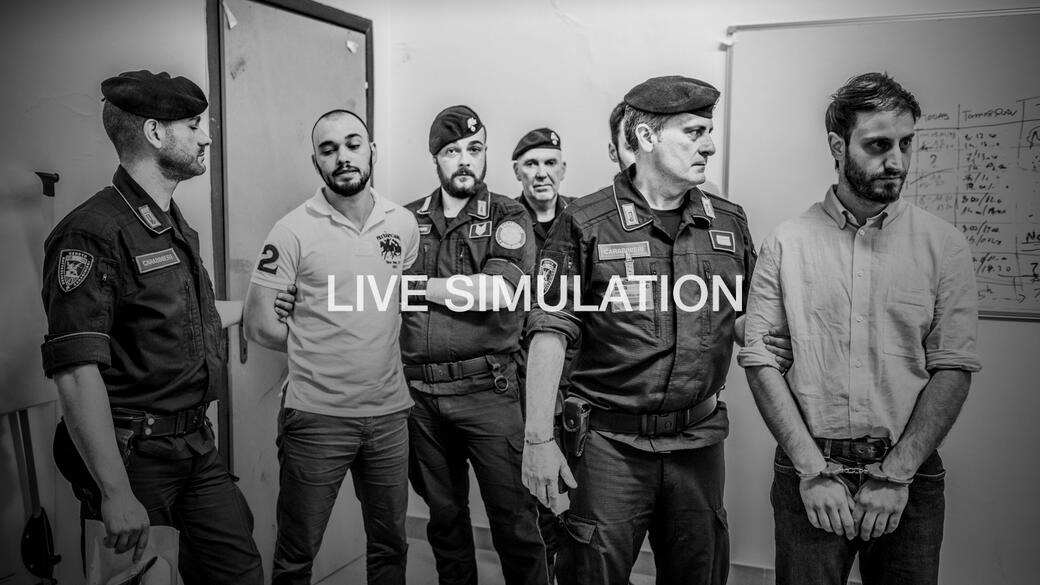Project
Combating Human Trafficking along Migration Routes


Quick links
- Project period:
- 2016 - December 2019
- Implemented by:
- Office of the Special Representative and Co-ordinator for Combating Trafficking in Human Beings
- Fields of work:
- Combating trafficking in human beings, Migration
Overview
The project “Combating Human Trafficking along Migration Routes” aims at enhancing the ability of interested participating States and Partners for Co-operation to effectively investigate/prosecute human trafficking and to promptly identify victims of trafficking in human beings (THB) along migration routes by promoting a multi-agency and human rights-based approach.
The project is divided into the following four phases:
- Project launch event on 17 June 2016 on the premises of the Centre of Excellence for Stability Police Units (CoESPU) in Vicenza, Italy;
- Development of training scripts focusing on a two-step learning tool which will encompass (a) lectures, and (b) a simulation for a multi-agency group of participants from interested participating States and Partners for Co-operation;
- Implementation of three simulation-based training exercises based on the developed scripts; and
- Consolidation and promotion of a training handbook with an innovative methodology to counter human trafficking.
Background
Despite participating States’ efforts to combat trafficking in human beings (THB) in the last decade, there are still significant shortcomings with regard to the identification of trafficked victims, criminal and financial investigation into human trafficking, as well as prosecution of traffickers throughout the OSCE region. These gaps have further widened due to the migration and refugee crisis which affects many OSCE participating States and Partners for Co-operation.
The OSCE region is witnessing massive movements of people caused by on-going conflicts, instability and lack of economic opportunity in neighbouring regions. These “mixed-migration flows” are comprised of refugees and economic migrants who are highly vulnerable to exploitation and human trafficking. More than one million people came to Europe in 2015, and of this total, around 10,000 migrant children have gone missing according to Europol data, with many believed to have been trafficked.
As part of its role in addressing this issue, the OSCE developed the project “Combating Trafficking along Migration Routes” to enhance the capacity of participating States and Partners for Co-operation to rapidly identify victims and effectively prosecute traffickers, thus strengthening the overall criminal justice response along migration routes.
This project, the first OSCE human trafficking simulation-based learning initiative, promotes an innovative approach to capacity building, whereby anti-trafficking practitionersanti-trafficking practitioners
Anti-trafficking practitioners include a broad range of professionals such as law enforcement personnel, public prosecutors, migration officers or asylum authorities, lawyers, labour inspectors, social welfare practitioners, NGOs, and journalists. from both participating States and Partners for Co-operation are called on to engage in real-time simulated scenarios to identify and investigate human trafficking, thus improving synergy among key national stakeholders. The live-exercises are based on realistic, expert-developed storylines to simulate cases of labour and sexual exploitation among migrants, including child victims.
Throughout the project, some 200 practitioners from law enforcement, the judiciary, financial investigation, labour inspection, public social services and NGOs will participate in three simulation-based learning exercises at the training facilities of the Centre of Excellence for the Stability Police Units (CoESPU) in Vicenza. In November 2016, the first simulation-based training was conducted for 55 trainees. Two other live-exercises will be organized in 2017 for approximately 150 participants. During the simulations, trainees hone their skills to pay attention both to the effectiveness of investigation and prosecution on the one hand, and to the protection of human rights through a victim-centered approach on the other. An important goal of the exercises is also to promote the use of financial investigations.
The handbook to be developed in the framework of the project will provide a step-by step guide to participating States on how to design and conduct simulation-based training exercises on human trafficking. Results and additional follow-up action will be discussed at a final event in Vienna in 2017.
Expected Results
- Strengthened capacity of selected practitioners from participating States and Partners for Co-operation to promptly identify THBTHB
Trafficking in human beings victims and conduct proactive and human rights-compliant investigations; - Development of a new capacity building methodology which provides participating States with a pragmatic framework to step up their THB training efforts and promote multi-agency co-ordination.
Partnerships
During the project, the OSCE and its Office of the Special Representative and Co-ordinator for Combating Trafficking in Human Beings is co-operating with the Centre of Excellence for Stability Police Units (CoESPU), managed by the Italian Carabinieri, to develop and organize capacity-building exercises in their training facilities in Vicenza. Key international actors such as EUROPOL, United Nations High Commissioner for Refugees (UNHCR), International Organization for Migration (IOM), United Nations Office on Drugs and Crime (UNODC), FRONTEX, INTERPOL and CEPOL are also being engaged to create synergies and avoid overlap.

